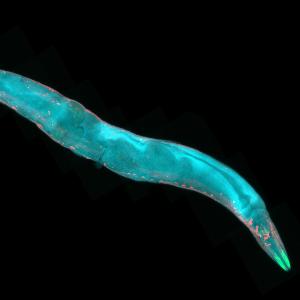Stroke therapy: Learning from nematodes
14 Dec 2021
LMU researchers have shown how a molecule from the worm C. elegans could protect the brains of stroke patients.
14 Dec 2021
LMU researchers have shown how a molecule from the worm C. elegans could protect the brains of stroke patients.

© ©heitipaves - stock.adobe.com
Each year, some 200,000 people in Germany and 1 million people in Europe suffer a stroke. This happens when blood clots obstruct major vessels and there is no longer sufficient supply of blood to the brain. If doctors manage to break down or mechanically remove the clot, further damage is prevented. Nevertheless, 100 percent of the tissue originally affected and about 70 percent of the cells in adjacent areas die off. Scientists based at the LMU Medical Center, the Charité in Berlin and the University of Maryland, Baltimore (USA), led by Dr. Francisco Pan-Montojo (Clinic for Psychiatry and Psychotherapy at University of Munich Hospital) has now been able to demonstrate in several relevant animal models of stroke that glycolic acid can be successfully used to salvage threatened tissue. The experimental treatment imitates a survival strategy of the nematode Caenorhabditis elegans a worm present in the soil, as the researchers report in Advanced Science.
The nematode C. elegans can withstand even desiccation by entering a special larval stage called dauer. Its metabolism stops as the worm dries— and reactivates again on contact with water. Both situations lead to a stress response with a huge increase in the production of reactive molecules (radicals), increased calcium levels in nerve cells, and functional changes in mitochondria, the energy-generating cell organelles. The fact that C. elegans survives this is substantially due to its ability to increase the production of glycolic acid in its cells upon desiccation, as experimental studies have shown: When glycolic acid production is inhibited, then it dies, whereas externally supplied glycolic acid has a protective effect enabling the worms to survive.
“In strokes, we see processes similar to those that take place in the desiccation and rehydration of C. elegans,” says Pan-Montojo. Therefore, the researchers investigated the hypothesis that glycolic acid could be used in mammals to reduce secondary damage resulting from a stroke. Indeed, experiments in various representative in-vitro and animal models of stroke showed that up to 100 percent of all nerve cells could be protected after administration of the molecule. The size of the affected region also decreased. “We were able to demonstrate that the protective effect of glycolic acid is mainly based on counteracting stroke-dependent calcium increases in the cells,” explains Pan-Montojo. “Our results indicate that treatment with glycolic acid has the potential to reduce mortality and disability in stroke patients.” Together with colleagues, Pan-Montojo has founded a start-up with the aim of advancing the step from research to application in patients.
Alexandra Chovsepian, Daniel Berchtold, Katarzyna Winek, Uta Mamrak, Inés Ramirez Álvarez, Yanina Dening, Dominika Golubczyk, Luis Weitbrecht, Claudia Dames, Marine Aillery, Celia Fernandez-Sanz, Zdzislaw Gajewski, Marianne Dieterich, Miroslaw Janowski, Peter Falkai, Piotr Walczak, Nikolaus Plesnila, Andreas Meisel, Francisco Pan-Montojo: A Primeval Mechanism of Tolerance to Desiccation Based on Glycolic Acid Saves Neurons from Ischemia in Mammals by Reducing Intracellular Calcium-Mediated Excitotoxicity. Advanced Science 2021